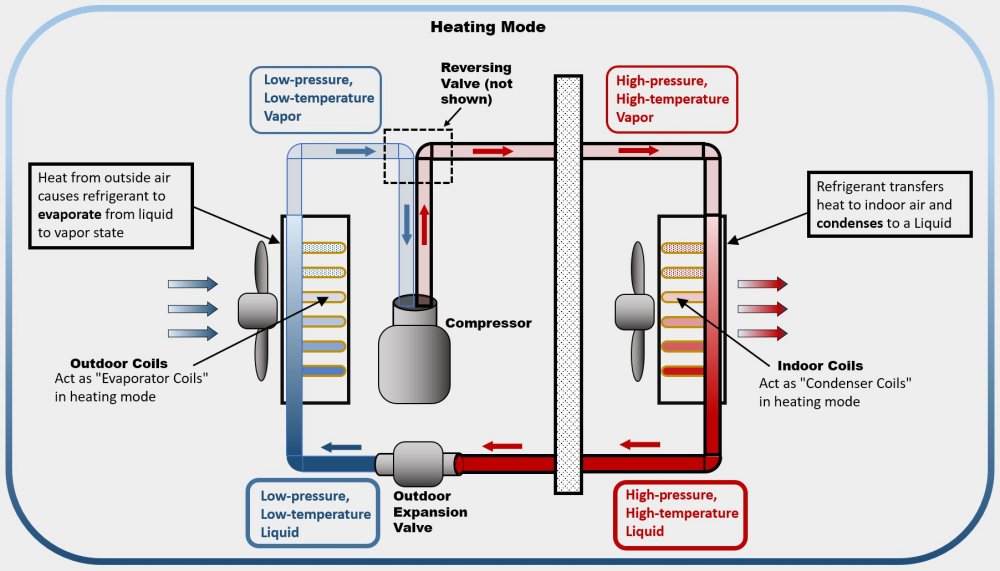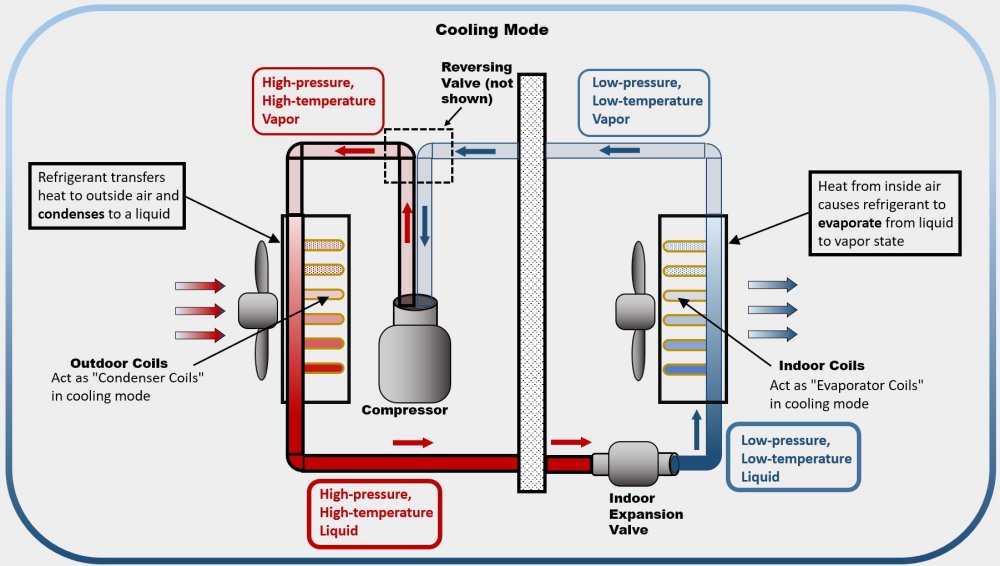In this article I am going to assume that you are in the market for completely new HVAC equipment. Perhaps yours
is an older system. The usual life of HVAC equipment is 15 - 20 years. You can figure closer to the 15 - or less - if you haven't been
having it serviced at least every 2 years, and/or you don't replace the filters at least once a year, and/or tend to keep a substantial
percentage of your vents closed (this makes the unit work harder).
In my case, the outside heatpump/airconditioner went out and the entire system is 17 years old. So, yes, I'm in the market
for a new system.
The intention of my article is to provide information on:
De-mystifying "EER" "SEER", "SEER2", "HSPF", "HPSF2" and similar terms.
The significant advantage in economy, energy efficiency, and comfort of going for a Heat Pump.
Deciding on the type of HVAC system - "Single Stage", "Two Stage", and "Variable Stage". (Applies to both air conditioning and heat pumps.)
Brief summary of the energy measurement acronyms
Cooling
EER Energy Efficiency Ratio. This is a measure of how efficient the unit is at full speed, usually measured at 95 degrees outside
temperature.
SEER is Seasonal Energy Efficiency Ratio. This is a measure of how efficient the unit is at an "average" operating temperature
over the cooling season.
SEER2 is the latest version of SEER - as of 2023. It is SEER, but measured under more realistic conditions representing a typical
ductwork system. The original EER and SEER were tested out in the open in a "hot" room and a "cool" room.
SEER2 is all you need to look at for cooling.
Heating
HSPF is Heating Season Performance Factor. This is the equivalent of SEER for heat pumps in heating operation.
HSPF2 is the latest version of HSPF - as of 2023. It is HSPF, but measured under more realistic conditions representing a typical
ductwork system.
No heat pump? AFUE is Annual Fuel Utilization Efficiency for a gas or electric furnace without a heat pump.
If selecting a heat pump only, HSPF2 is all you need to look at.
If selecting a combo heat pump/air conditioner, HSPF2 + SEER2.
If selecting a furnace only, AFUE is sufficient.
Here's what all these terms mean when you are making decisions on the components for your HVAC system:
SEER2 relates only to air conditioning (cooling). Note that this applies to both a standard air conditioner as well as to a heat pump when
it is working in the cooling mode (they do both).
Thus a higher SEER2 is desireable for hotter areas, such as Texas, Florida, or Arizona, or just about any state south of
the 35th parallel.
But keep in mind that all areas get hot at times nowadays. When we moved to Oregon (from Texas) in 2011, the
summers in the interior were delightful compared to Texas. There were a few stretches of middle 80s, and possibly an occasional
90. But most of the time temperatures were in the middle 70s.
It's not like that in 2024! There are many periods of 90+ temperatures, along with occasional 100 degree days.
HSPF2 relates to heating with a heat pump. Thus a higher HSPF2 is desireable for cooler climates.
For furnace only systems (gas, propane, oil, or electric) a higher AFUE is desireable.
But again, it can get quite cold on occasion even in Dallas, Texas. So a higher SEER2 might be appropriate.
Actually, for the most part, a system with higher SEER2 rating usually have a higher HSPF2 rating. Do note that you have to replace both the outside unit and the inside unit as a set in order to get the full effect of the more efficient systems. An older inside unit - the "air handler" - will not work properly with a new modern outside unit.
So. . . why get a heat pump?
I am now going to try to convince you that you "need" a heat pump!
I used to think that heat pumps were a bit silly. They would blow tepid air for a period, and then the "real" heater would come on and
heat the house up. But this applied to older models. Newer equipment is much better.
A heat pump is superior because it moves heat.
A furnace has to create heat. It takes a lot of power to convert one form of energy (electric or gas) to another (heat).
Need some numbers?
For 1000 Watts of electric energy, a furnace can provide 800 - 950 Watts of heat (depending on the AFUE rating).
For 1000 Watts of electric energy, a heat pump can provide 3000 - 5000 Watts of heat (depending on the efficiency - HSFP2 rating)!!
A heat pump can save you 50% or more of your heating bill, according to the Department of Energy.
But wait, you say. How can there be "heat" at 35 degrees outside? Actually there is available heat all the
way down to absolute zero. It used to be the case that heap pumps were good down to 35 - 40 degrees. (Many sites still say this!) But
now there are units that are useful down to 5 degrees and even lower. According to "natural-resources.canada.ca", there were over
700,000 heat pumps installed in Canada in 2022!
You are actually quite familiar with heat pumps! An "air conditioner" is a heat pump. A refrigerator is a heat pump!
But wait. There's the COMFORT thing. (There are THREE different types of heat pumps):
It's not just all about energy efficiency and economy. A heat pump can easily provide a much higher
comfort level, especially with the higher end heat pumps.
Modern heat pumps are available in three levels:
Single stage. The unit is either complete on or completely off. In any given heating cycle, the unit is on for a while, then off for a longer period.
Two stage. The unit has two stages. One is 50 - 60% of full capacity. The second is 100% of capacity.
Variable stage. The unit can run at various percentages of full power, depending on the demand.
Here is where the "comfort" comes in for heat pumps. As an example, my older heat pump stopped working
a few months ago. This meant I was down to the the standard electric furnace. This furnace would blow hot air for 5 to 10 minutes
and I was comfortable. But then it was off for the next 30 - 40 minutes or so, and after about 15 minutes I found myself reaching
for the second flannel shirt.
When the heat pump was working, it would blow warm air for 15 to 20 minutes, providing comfort. But then it cycled off for about
25 - 35 minutes, and it still became somewhat chilly.
A two stage unit can run for longer speeds at the 50 - 60% level and at full speed less often. So there would be shorter "no heat"
times.
But with the variable stage heat pump, there is essentially no uncomfortable period! It can run almost continuously, but at a low
speed, and can maintain a temperature swing of less than 1 degree.
Summary of the advantages of a Variable Stage Heat Pump
A variable stage heat pump can provide much quieter operation - no more noisy outside unit. I was watching a video of a person describing a variable state heat pump, with one in the background. After talking for a bit, he said, "Oh by the way, this has been on all this time!"
It can provide a much higher comfort level. No more long "off" periods.
Since the unit is on for longer periods of time, your indoor is getting filtered more. This can be a big deal for those folks with allergies.
Note that there is an additional benefit for a variable stage heat pump when it is operating in cooling mode. Since the unit is on for longer periods of time, it is lowering the humidity as well. This applies also for a variable stage air conditioner (no heat pump). Air conditioners are available in variable speed as well.
OK, there might be a disadvantage to Variable Stage Equipment: It's a bit expensive.
For my own quote for HVAC replacement, the total cost was $11,500. However, to change from single stage to
variable stage heat pump/air conditioner was an additional $4,500.
But if you consider the better comfort, quieter noise level, and considerably better energy efficiency, the additional
price of variable Stage makes sense. Further, your electrical bill will be less as well.
"Go for it", I say.
So. . . How do all these Gadgits work?
Want a bit more information on the technical side of all this equipment? Here are some diagrams.
A little background info:
The whole business of heating (with a heat pump) and air conditioning works because of
"phase" changes. Changing from a liquid to a vapor is a phase change. So is changing from a vapor to a liquid.
It takes one calorie of heat to heat one gram of water one degree C. So it takes 100 calories to heat
one gram of water from 0 degrees C to 100 degrees C.
But it takes 540 calories of heat to change one gram of liquid water at 100 degrees C to steam (vapor)
at 100 degrees C - the "phase change".
So if you allow one gram of water at 99 degrees C cool to 98 degrees, you get 1 calorie of heat.
But if you allow one gram of steam at 100 degrees C to condense to liquid, you get the 540 calories of heat
back!! That's the "Latent Heat of Condensation".
If you allow a vapor to condense, it heats. And the heating is intensified because it is a phase change.
If you allow a liquid to evaporate, it cools. And the cooling is intensified because it is a phase change.
Without any other action, heat always flows from the hotter object or area to the colder object or area.
Here is a simplified diagram of the fluid flow within a typical heat pump while in the heating
mode. |
 |
|
And here is a simplified diagram of the fluid flow when the heap pump is in cooling mode. |
 |
Two notes about these diagrams:
The Reversing Valve is shown in the diagrams as a simple dotted rectangle. Its internal construction is not shown.
But it functions to redirect the flow when the unit switches betweeen heating and air conditioning modes.
The inside and outside Expansion Valves have a special valve (not shown) near them to allow only the Indoor Expansion
Valve to be used for the cooling cycle and only the Outdoor Expansion Valve to be used during the heating cycle.
And one final observation:
It might be noted that the overall effect of cooling and heating is to pump heat in the opposite direction
that it naturally flows, which is from something that is hot to some other thing that is cold.
With heating (heat pump), we are pumping heat from a colder area (outside) to a warmer area (inside)
With air conditioning, we are pumping heat from a cooler area (inside) to a hotter area (outside).
So one might say that all this heating and air conditioning business is our rebellion against entrophy!
Copyright © 2024 J.A.